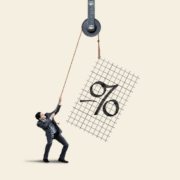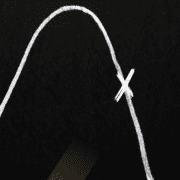The Lazy 1970’s vs. the Frenetic 2000’s
To listen to the audio version of this article click here.
Many people today see the Fed’s Quantitative Easing as money printing. They remember what happened in the 1970’s, and they instantly jump to conclusions. However, we live in a different world. To illustrate this, consider the following story about Joe, a promising and eager young manager in a struggling manufacturing company.
Joe excitedly walks into the boardroom and pitches his idea. “Let’s borrow a billion dollars. We can use it to build a massive warehouse and to buy massive quantities of our raw materials!”
The senior management team stares at him. The CEO demands, “Why?”
“We need to have a stockpile at every level. We should start with 3 months of raw materials, and a three-month buffer of work-in-progress in between every one of the 27 steps of our manufacturing line. And even better, we need to warehouse finished product. We shouldn’t ship anything that hasn’t been sitting for at least 4 months. Ideally six, but we can start with four.” Joe has the bit in his teeth now.
He rushes on. “Bernanke has printed so much money, and Yellen is going to continue. We already have massive inflation and it’s going to get worse! By borrowing to buy stuff that is only going up in price, we can make extra profits and protect ourselves from supply shocks as the cost of commodities rises out of sight!”
The CFO leans over to whisper in the ear of a young assistant, Bill. Bill does a quick Google search and finds the price of copper, which is one of the most important raw materials the company buys. Bill puts the copper chart up on the screen. It has fallen a third over the past few years.
Joe will be lucky to remain employed when he leaves the room. To be fair to him, his mistake is simply to try to implement a business strategy around what most casual observers and many economists believe.
Sometimes, the best way to debunk an idea is to take it seriously.
Inventory, Borrowing and the 1970’s
Though it makes no sense today, holding inventory was not the crazy idea of a young fool back in the 1970’s. It was how many businesses conducted business. In that era, the game was to accumulate inventories. The more, the better. First people were trading excess cash for inventories. I can recall my parents stockpiling things like canned tuna fish. It was better to keep one’s wealth stored in a durable food product than in a bank account. Consumer prices were rising about 20 percent per year.
Next, companies began selling bonds to finance inventory growth. This pushes down the bond price, which is the same thing as pushing up the interest rate. And of course it pushes up prices.
In the 1970’s, cash was trash. Inventories rose relentlessly in value, at least as measured in terms of the dollar. This, by the way, is a great example of how irredeemable money distorts the economy. You aren’t producing any more, or creating any kind of new wealth, and yet, you are rewarded with a profit.
How is Today Different?
Now we have the opposite condition. Since the interest rate began falling in the early 1980’s, companies have been finding ways to reduce inventory accumulation. The Lean manufacturing movement began to gain acceptance at this time. Lean, also known as the Toyota Way, defines inventory—such as work-in-progress sitting on a shelf—as waste. Lean is all about eliminating waste.
Today, cash is king. Excess inventory quickly become obsolete.
Companies are not borrowing to hold inventory, but to expand production when they can make a profit above the cost of capital. Since the interest rate keeps falling, the hurdle to get over for minimum acceptable profit keeps going lower.
Think of it this way, if you manufactured handheld electronic devices, would you want to keep inventory a minute longer than you had to? Of course not, because your competitor is about to release a new model that will make your product less desirable, or even unsalable. How about clothing? Cars?
In the 1970’s, the interest rate was rising. When a worn-out plant needed replacing, it may not have been feasible to borrow to replace it. That’s because the new interest rate was much higher than at the time when the plant was first acquired, a decade or more earlier.
This is the connection between the rate of interest and the rate of profit. It’s impossible to borrow at a higher rate than the profit one hopes to earn. A rising rate will therefore lead to rising margins, and a falling rate to falling margins.
The Lazy vs Frenetic Pace
Other than the problem of financing plant replacement, business was easy. Sleepy conglomerates had travel policies that allowed managers and executives to fly first class, even for domestic travel. With the cost of borrowing rising all the time, profit margins were expanding. And there was the kicker, holding inventory before selling it fattened margins further.
Business had a lazy pace to it, as I look at it today (though business managers at the time might not have agreed with that characterization).
In comparison, today it is the opposite. Limitless oceans of dirt-cheap credit issue forth, like effluent from the world’s central banks. The problem is not replacing worn-out plant when the cost of capital is higher. The problem is that every competitor has ever-cheaper cost of capital. The challenge is that rapid product cycles are driving rapid obsolescence. It is harder and harder to recoup design and tooling expenses. Inventory that sits for a week may have to be liquidated at a massive discount. Profit margins are under constant pressure.
Business executives routinely fly coach, even for international travel.
If the word for the 1970’s business environment was lazy, the word for today’s climate is frenetic.
Neither is the ideal behavior for a rational enterprise. They are the direct fault of the regime of irredeemable paper money.
The CPI Sleight of Hand
Everyone’s attention is misdirected towards prices. Is the Consumer Price Index rising? Is it rising more than expected? How about the producer price index? Is that dropping into the dread D-word—deflation?
It’s the greatest economic sleight of hand ever perpetrated.
Instead of zeroing in on prices, we should be looking at the enormous distortions of our centrally banked irredeemable currency. We have bubbles, malinvestment, insolvencies, volatility, with exponentially rising debt and derivatives outstanding.
Additional Resources for Earning Interest on Gold
If you’d like to learn more about how to earn interest on gold with Monetary Metals, check out the following resources:
In this paper we look at how conventional gold holdings stack up to Monetary Metals Investments, which offer a Yield on Gold, Paid in Gold®. We compare retail coins, vault storage, the popular ETF – GLD, and mining stocks against Monetary Metals’ True Gold Leases.
The Case for Gold Yield in Investment Portfolios
Adding gold to a diversified portfolio of assets reduces volatility and increases returns. But how much and what about the ongoing costs? What changes when gold pays a yield? This paper answers those questions using data going back to 1972.










Keith, in the light of your series of papers on Interest and Prices in Paper Currencies do you think we are on the verge of reversing cycles? Perhaps temporarily? If the interest rate spikes and we go back into a rising cycle with the positive feedback loop of rising interest rates and rising prices of commodities? I think in the end of part VI you mention the possibility of volatility in the bond market turning this way. https://monetary-metals.com/theory-of-interest-and-prices-in-paper-currency-part-vi-the-end/ Thinking out loud here but it seems this would be equally disastrous especially in light of your article here highlighting that today is not the 70’s. Today we are the most indebted society to date. Much of that debt will never be repaid because we lack the appropriate mechanism. I am trying to work it out in my head. If we turn to a rising interest rate, perhaps temporarily, wouldn’t that destroy the asset side (bonds) of central bank balance sheets and the balance sheets of others who have been buying bonds? Falling interest erodes capital, rising interest destroys capital when business have to fold because rising cost of capital eats into margins. Any thoughts on what a rising cycle would look like today under the mountain of debt we have? If you have already written on this subject simply point me in the right direction and i will gladly take a look.
Rereading this again too…
https://monetary-metals.com/rising-interest-rates-spoil-the-party/
Which I think answers the majority of my questions. What still seems to confuse me is the effect this would have on paper currencies, specifically on the dollar since it is the liability of the federal reserve. Other than companies and banks becoming insolvent and defaulting due to the rising interest rate. What happens to the liability of the FEd?
Thank you Keith.
That’s an interesting question Wally.
I think you hit the nail on the head, if the rate begins to rise meaningfully then defaults will begin. I don’t believe the rate will rise more than it already has, but obviously such a prediction is fraught with unknowns–both known unknowns and unknown unknowns.
I have some additional ideas and may write more on this topic soon.
Interest rates cannot be allowed to rise. Every intervention taken by central banks has one prime purpose: to drive interest rates to the lowest possible bound.
If interest rates ever rise again, that’s the death knell for all industry worldwide. Industry is debt driven…borrowing at lower and lower costs. That is what drives the economic engine.
However, if central banks keep creating currency to do this, the currencies will hyperinflate.
I myself think they have a few more tricks up their sleeve. You see, a low interest rate is an incentive to save more, to make up for lost interest income. At some point they will have their eyes on these accounts and confiscate them in some form, with the perverse idea that they need to keep the banks alive. Bail-ins and bank holidays are a given.
Once this happens, then people will finally realize they needed to save in gold outside the system, but by then it might be too late.
Knowing this, the thing that people should do is keep just enough in a demand deposit at a bank for ongoing expenses, maybe a little for emergencies, but that’s it. Everything else should be in physical assets held outside the banking system…land, property owned outright, gold, etc.
It is a given at this point that the global banking system will fail, it’s just a question of when.
Owning land, property outright, gold, etc. will not help you if TPTB know you have it. It will be confiscated when they believe it necessary.
It seems to me the only things safe are the items a man can hold without ‘registering’ with TPTB. Those items need to be held in a place not obvious.
This discussion explains so much of what I saw growing up in the economy of the 1970’s versus what I am seeing today. As a kid in the mid-1970s I recall going to a farm equipment dealer with my father to get a price on a new tractor. The salesman quoted my father full list price. Sometimes, the dealers would even charge over list. I have an aerial photo of the same dealership taken in 1977 showing a line of brand new tractors that stretched from one end of the lot to the other. As you point out, rising interest rates encourage hoarding of inventory, no matter whether they are finished goods or components at the manufacturer’s level. Retail margins were fat and growing and manufacturers had tremendous pricing power. Retailers would buy as much inventory as financially possible because they knew the price could only go up.
Contrast that to today when farm equipment dealers can’t move anything without steep discounts and early order programs. Margins are thin and getting thinner, and dealer lots are generally pretty empty because no one wants to sit on inventory. I work for a farm equipment manufacturer and I am now seeing a worrisome obsession with just-in-time manufacturing. The purchasing department has strict quotas on inventory and progressively shorter allowable lead times which make it more and more difficult to meet a production schedule. We’ve also purchased a lot of sheet metal fab equipment even though the area we are located in is literally saturated with shops with identical equipment and not enough work for all of it. I think that declining interest rates play a key role in forcing manufacturers to embrace what I see as questionable strategies.